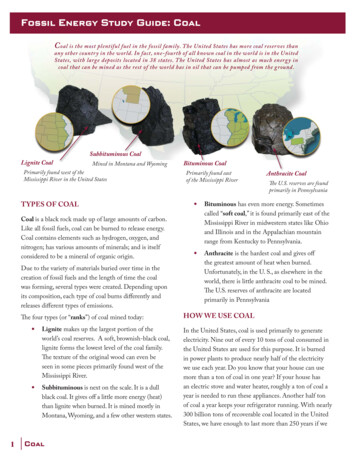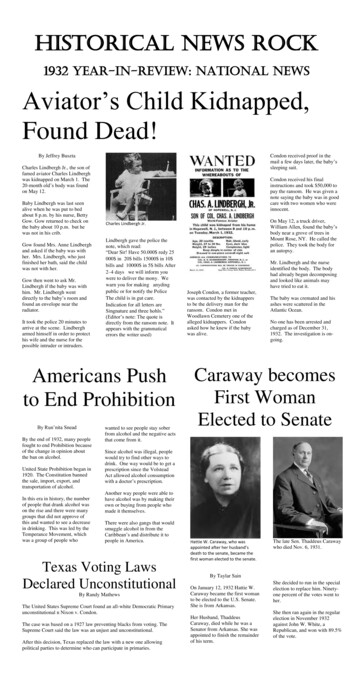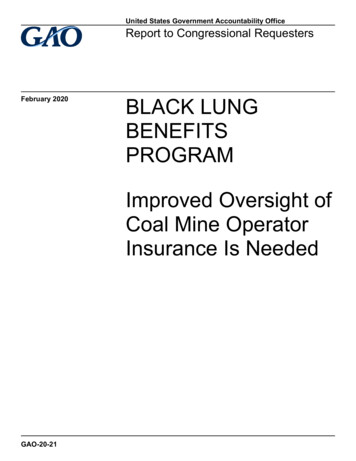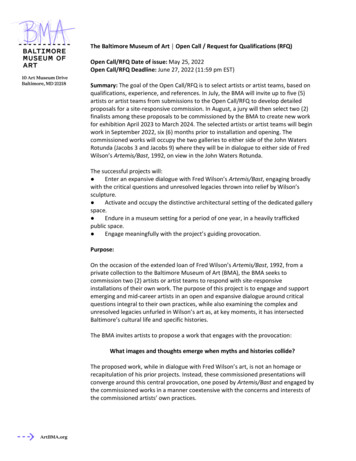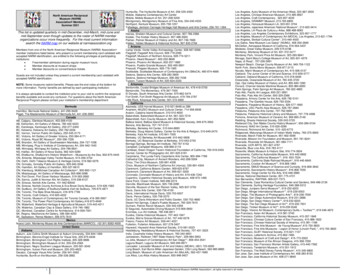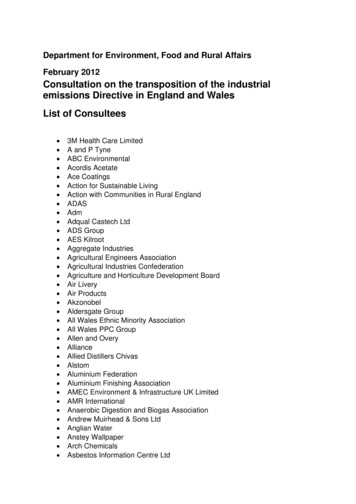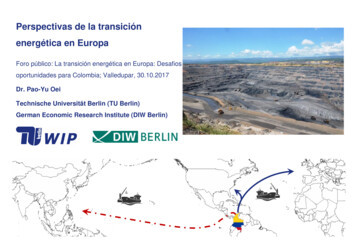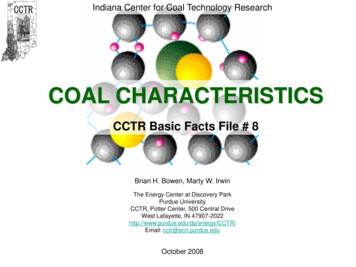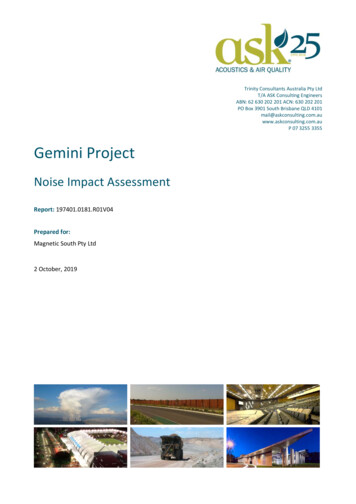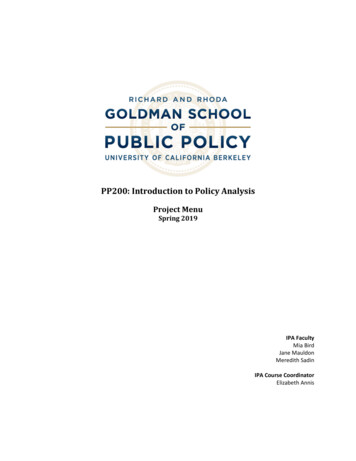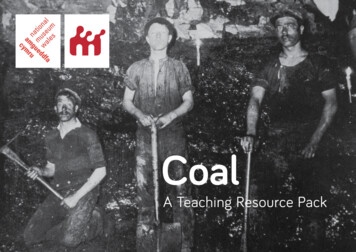
Transcription
CoalA Teaching Resource Pack
IntroductionHow to use this resource:This resource has been created to stimulate independentinvestigation of coal and coal mining in the South Walescoalfield. This also supports the ‘From Pithead to Sickbed andBeyond’ travelling exhibition.This resource is divided into five separate investigations thathelp prompt your own classroom enquiry around the history ofmining in Wales.Intended outcomes:At the end of this investigation it is expected that pupils willhave increased knowledge and understanding of changes indaily life during the nineteenth century. The investigation willalso be relevant for all skills across History as well as Scienceand Geography.You may choose to carry out one, or all investigations duringyour study.An iBook resource is also available with accompanying imagesand video to support your learning.Two miners ready for work. Amgueddfa Cymru
Investigation 1COALWhen was coal formed?Most of Britain’s coal seams were formed from the remainsof plants growing 280-300 million years ago in forests.Similar forests are found today in places like the Everglades(Florida, U.S.A) but many of the plants are different. The forestsformed in Britain’s coal seams, existed in the period called theCARBONIFEROUS period.Some coal seams (in Australia and parts of Europe)formed BROWN COAL which took much less time todevelop, and is only about 80 million years old.How was coal formed?The coal mined in Wales was formed millions of years ago andis made up of layers of trunks and branches of trees which grewin vast swamps.When a tree dies on dry land it is soon rotted by bacteria. Inorder to break down the wood, the bacteria needs oxygen fromthe air; but if the tree falls into swampy water, it cannot rot awaycompletely because there is not enough oxygen. Therefore inswampy areas, thick layers of wood can accumulate below theReconstruction of the levee of a river that flowed through the tropical wetlands300 million years ago. The plants growing on these levees are often found asfossils in the rocks associated with coals in Wales. Painting: Annette Townsendwater, and the weight gradually squeezes out the water from therotting plants. Over millions of years many layers of differenttypes of coal are formed.The deeper the coal seam, the better the quality of coal. This isbecause the deeper levels are older and have been squashedmore, leaving higher concentrations of a substance called carbonwhich means that the coal gives off more heat when it is burned.
Investigation 1Coal is a fossil fuel. This means that it is a material which canbe burned and has been made from the remains of plants whichlived millions of years ago.Sometimes you can find the remains of these plants in a pieceof coal showing the imprints of delicate ferns and leaves, andperhaps the patterned imprints of the great ancient tree trunks.What was found in Coal?Scientists have identified a number of plant remains in coal,these include: bark, leaves, seeds, stems and twigs as well asspores (pollen). The bark, leaves and seeds were often found inthe rock on top of the coal. The stems, twigs and spores weremost often found underneath the coal.Since these plants havebeen dead a long time theirpreserved remains are calledfossils thus fossil roots, fossilstems and fossil leaves.It is thought that around 10mof plant material forms just1m of coal.The leafy shoot of a giant lycophytefrom the Upper CarboniferousLlantwit Beds of Beddau, south Wales.Amgueddfa CymruReconstruction of giant lycophytes growing in tropical wetlands of Wales,about 300 million years ago. Note that there are plants in different stages oftheir life-cycle. Painting by Annette Townsend. Painting: Annette Townsend
Investigation 1Different types of coalPeat or Lignite – is the first stage in the formation of coal. It canform within a few hundred years of the dead plants being buried.It is soft because it has not been buried under heavy layers ofmud, sand and rocks. It is the poorest form of ‘coal’ as it containsthe least carbon. In some areas of Wales peat was cut and driedand used for cooking and heating.Brown coal or Subitumous – is a slightly better fuel than peat.These have been buried and hardened and so contain morecarbon. It is a soft, black coal often used on fires in homes.Bituminous Coal – is found at deeper levels and so is muchharder and richer in carbon. It is a medium-hard, black coal oftenused on fires in homes.Anthracite – is the hardest coal and is usually found at thedeepest levels. It is a hard, shiny, black coal and contains thehighest levels of carbon.It was mined in south-westWales and was primarilyused in central heatingsystems and by industry.The Anthracite coalmined in Wales was mostsought after.Thin sections of coal magnified x 6.3 showing how the specimensare made up of organic layers. Amgueddfa Cymru
Investigation 1A common sequence through the Carboniferous Coal Measuresarea is:Covering an area of about 1,000 square miles, the SouthWales Coalfield is the largest continuous coalfield inBritain. This region has played a very important role in thedevelopment of Britain and the world. Used for smeltingmetals and powering steam engines, Welsh coal helped fuelthe Industrial Revolution.Coal was mined in South Wales long before the IndustrialRevolution, but it was during the nineteenth century thatcoalmining really began to expand. Welsh coal was famousfor its steam producing qualities. The rise of steam-poweredtechnology in the second half of the nineteenth century,increased the demand considerably. To meet this need, newcollieries opened, more miners were employed and mineswere driven deeper than ever before.At its peak in 1913, the South Wales Coalfield was the mostproductive in Britain and employed nearly a quarter of amillion men.
Investigation 1A map showing the South Wales coalfield. Amgueddfa CymruSuggested activities: Draw a diagram showing the life cycle of plants and how theyform coal. Using maps identify the coalfield areas. (Map included)Move on to identify mines in your local area – Investigation 2. Identify the main uses of coal. Investigate other types ofenergy and what they are used for. Visit Mr Trevithick at the National Waterfront Museum andlearn more about his steam locomotive.Replica of the Penydarren Steam locomotive. Amgueddfa CymruUseful links:www.bbc.co.uk/nature/history of the earth/Carboniferous
Investigation 2Where is coal mined?During the Roman period, coal, gold, copper,silver and Zinc was mined in Britain.There is evidence of mining in theBlaenafon area going back to the 14thcentury, and of mine workings at Mostyndating as far back as 1261.In the very first mines the coal had to becarried out to the shaft in baskets or pushedor dragged out on wheeled carts by workersusing a belt and chain. When there wasa particularly heavy load a winch systemwould be used to haul material through theshafts and up steep gradients of the mine.Once larger scale metal smelting began,areas such as Swansea grew to be majortrading areas. Metal ores from mines inCornwall were brought to Swansea to besmelted using the local coal.Glamorgan Colliery, Llwynypia about 1920. Amgueddfa CymruUseful links:www.nmrs.org.uk/mines/coal/maps/wales2.html
Investigation 2Suggested activities: Locate the names of the local mines or industries where youlive. Ask relatives if they have any stories about coal mining orindustry in your local area, record their stories. Plan a trip to visit Big Pit: National Coal Mining Museum toexperience descending down a real mine. Find out what other industries there are in the different areasof Wales. Create a table to record the findings and showresults in a bar chart or pie chart.
Investigation 3Employment – Working in a MineJobs in the MineCollier - These are the miners who cut the coal from thecoalface. For hundreds of years they did this by hand using only amandrel (coal pick). Today coal face workers use drills, explosivesand high powered machinery to do the work.Haulier and pit pony. Amgueddfa CymruHauliers – Hauliers worked with a horse and dram to haul outthe coal which the colliers had cut. Usually each haulier kept tothe same horse and the two worked together day after day foryears and years. They grew to understand each other very welland horses often knew what they should do next without havingto be told by their hauliers. Hauliers were proud of their horses’intelligence and became very fond of them. However this wasnot always true, if the haulier was young and inexperienced andnot used to working with horses they could be very badly treated,if the horse didn’t do what the haulier wanted they often resortedto cruelty.Miner at work. Amgueddfa CymruIn 1913 there were over 70,000 ponies working underground inthis country.
Horse rescued from Senghennydd disaster 1913. Amgueddfa CymruHorse keepers – These looked after the horses when theywere in the stables. They looked made sure the ponies werewell groomed and given plenty of good food and fresh drinkingwater. There were rows of stables underground, each divided intoseparate stalls. Each pony had their own stall with its name abovethe manger. The ponies quickly learned which their own stallwas and, at the end of a hard day’s work, they trotted through thestable into the correct stall without help.Did you know?r 15 hands high and notWelsh collier y horses were usually ove13 hands were kept fortechnically ponies, although some ofmines who saw them workingworking in ver y low areas. Visitors tols were – in fact Shire horsescommented on how big these animae major collieries!were used in the main roadways of som
Investigation 3The Blacksmith – Blacksmiths made iron shoes for horses in theforges above ground and took them down to the stables in thepit. When the ponies’ shoes wore thin and broke, the blacksmithtook them off, trimmed the hooves and nailed on the thick newshoes. Shoeing does not hurt (it is like cutting your nails). The Ironshoes protected the ponies’ hooves from being broken on therough underground roadways. When a new horse was recruited,a set of shoes to fit him was made and kept as a pattern in theblacksmiths’ shop. When he needed new shoes a set was madefrom the pattern and sent underground to be fitted ‘cold’.A blacksmith shoeing a horse at Lewis Merthyr Colliery, about 1910.Amgueddfa CymruThe Veterinary Surgeon – This man is usually called the ‘vet’.Each big coalmine employed a vet because there were often asmany as 600 horses working underground in one pit. Beforethe National Coal Board was established, each colliery companyemployed their own vet – they weren’t part of the collieryworkforce itself. The vet took care of any ponies injured whilstworking. The vet checked their diet to make sure they had enoughgood food to keep them fit for their hard work. He checked theirharness to make sure it fitted properly and did not rub their skin.In the twentieth century horses began coming up for an annualholiday of two weeks when miners had their holidays. The vetwas the person who arranged their holidays in good safe fieldsnear the collieries. Horses often worked from ten to twenty yearsin coalmines. If well looked after horses could stay fit and stronguntil they were quite old. As with the collier horses also faced thedanger of the mines, in 1914 the RSPCA stated that, out of 70,396animals in UK mines, 2,999 were killed and 10,878 received nonfatal injuries.Many horses suffered from lacerations, ‘grease heel’, which camefrom working in wet conditions, chest ailments from breathingdust, cataracts and many other problems. Before the NationalCoal Board, horses which became too old or ill to work weresent to the ‘knackers yard’ for horse meat. When mining becamemore mechanised in later years and the need for horse powerdecreased, horses might be luckier and sent to a ‘rest’ home.
Investigation 3Children in the MineDoor attendants or Trappers – opened and closed the largewooden doors that let air into the mine tunnels.Putter – The putter would push drams (truck) of coal alongthe mine tunnels.Dram – This was what the putter pushed along the minetunnel, the dram carried coal from the seam to the surface.Curling box – This was used by workers to scoop up coal andloaded into a dram. Coal was carried and placed in dramsvery carefully to avoid breaking up lumps – there was noprofit for either collier or owner in coal dust and small coal.If a collier was caught using a shovel to fill the curling box hewould be fined! Once full it would be emptied into the dramuntil it was full.Many children were employed to work underground. Boys andgirls as young as 6 years old would work as ‘door boy’ or ‘doorgirls’ opening and closing the air doors that regulated the airflow. They would sit for hours in the cold and dark with onecandle for light. If the candle went out it was expected that achild would wait until someone else came along to the candleagain. This was not always the case however, children oftenwandered off to talk with other children working in the mine.Illustration from the mines Report 1842Children also work as drammers, they were small enough togo in the lowest areas of the mine roads – places where adultswere too big to fit. There was hardly any mine that had rules thatstopped young child from working underground. However, in somemines this was not the case. In a mine near Llansawel childrenunder eight years old weren’t employed, similarly in Margam themine didn’t employ children under nine years old.Did you know?the seams so were onlyIn this period the roads were made inich could be only a few feetthe height of the particular seam whes were ver y low.high. Therefore most roadways in min
Investigation 3During the 1840s the Government began to look into theemployment of children. Inspectors were sent to the coal minesto talk to the owners and the children about their work and pay.Many told lies because a lot were worried they would lose theirjob, the mine owner was happy to go along with it because hehad cheap labour.A lot of people were against bringing child labour to an end, butthe Mines Act was passed without too much opposition in 1842.After the Act was passed in Parliament, it was against the lawto employ anyone under the age of 10 to work undergroundin the mine. Although it was unlawful, and inspectors calledregularly, many people still sent and employed children to workunderground. Later on the Act was changed and it then becameunlawful to employ anyone under the age of 12.Did you know?o stipulated a half daysIn 1872 the Mines Regulations Act, alsyears of age.schooling for boys between 10 and 13Evidence from the Mines Report, 1842level. We“We are door-keepers in the four footng and areleave the house before six each mornimetimesin the level until seven o’clock and solight costslater. We get tuppence a day and ourl (her sister,us tuppence ha’penny a week. Rachaewhile ago andaged 12) was run over by a tram agot over it.”was home ill a long time, but she hasElizabeth Enoch, age 10, who workedsister for one year.underground with her“I have been down aboutthree years. When I first wentdown I could not keep myeyes open; I don’t fall asleepnow, I smoke my pipe.”William Richards, 7 years old.Draft door boy, he was paid 8 pencea day when there was work for him.Young boy workingunderground.Amgueddfa Cymru.Extracts taken from the Children’s Employment Commission (Mines 1842).
Investigation 3Example of the weekly spending of a mining familyin Victorian Wales:Remember there are 240 pennies in a 1 (pennies was usually written as d.)There are 12 pennies in 1 shilling and 20 shillings in 1.Suggested Activities: Use the information from the job descriptions that wererecorded in the mines report 1842, as a stimulus forcreative writing.www.cmhrc.co.uk/cms/document/1842 S Wales 2.pdf Use the family shopping list to investigate how spendinghas changed. Compare modern day prices of commongoods such as sugar, tea or coffee and find their cost today.Record your findings in a table. To find the modernvalue of pre-decimal prices follow the external link to theMeasuring Worth website.www.measuringworth.com/ppoweruk To see an example of an original miners wage slip fromCoytrahen Park Colliery, follow this link to the People’sCollection Wales website.www.peoplescollection.wales/items/434778 Research modern examples of child employment acrossthe world. Horses often suffered as much as the collier in its everydaywork in the mine. Investigate modern examples of animalcruelty in the workplace. Use the learning resources for ‘Children of the Revolution’on Big Pit: National Coal Museum ion/
Investigation 4What were the dangers ofworking in a mine?Unfortunately there were many disasters, places such asSenghenydd, Morfa or Aberfan became infamous. A miner couldbe injured carrying out his daily work and families were alwaysanxious and dreaded the news of an explosion or collapse thatmeant a loved one would not be returning home.The work that children did in the mines was very dangerous andthe fact that there were often few safety rules resulted in manyserious injuries and deaths.Children were affected by working long hours in poor conditionsfor up to twelve hours a day, six days a week. In winter sometimesthey would not see daylight from one day to the next. With onlyone day off a week on Sunday, they had little time to rest or playand could not go to school.Did you know?for transporting coal cutAs children were usually responsibleworked longer hoursby the adults out of the pit, they usuallythan the colliers!Picture taken after the Senghenydd mine disaster in 1913.The sub-commissioners of the Mines Act report were veryinterested in children’s health and how they were affected byworking in coal mines. Their report includes tables of informationabout the children’s height, weight and ‘physical condition’. Onone of them it was reported that a child was ‘sadly deformed inspine and shoulder’.As well as dangers from working in a mine, there was alsodangerous gases that could accumulate underground.
Investigation 4When people were mining coal before the 19th century the onlyway of knowing that gas was present was by watching the openflame of the candle used to light up the darkness. The flame ofthe candle would change its colour and shape when there wereexplosive gases present and grow dimmer if there were chockinggases present.In the simplest early pits (around the medieval period) it wasusually the job of a an adult called a ‘penitent’ or ‘fireman’ to goin before the men started work in order to ‘fire’ off any explosivegases present that had accumulated overnight. This was usuallydone by using an open flame to light the gas!Before the first half of the 20th century if there had been anyaccidents in the mine, the rescue team sent in would often carrya mouse – preferably a wild one - with them. Canaries laterbecame most commonly associated with detecting poisonousgases. These small animals often breathe much faster thanhumans. They get affected quicker by the gas, giving the minersplenty of warning to get out.Mice and canaries were usually used to detect choking gasessuch as Carbon Monoxide.Image of miners with canary in cage. Amgueddfa Cymru
Investigation 4Lamps were also used to detect gas in a mine. The flame of alamp would change colour and shape if there were explosivegases around, and would grow dim or go out if choking gaseswere present. Before the Flame Safety Lamp was introduced,using open candles would have been very dangerous. The flamefrom the candle could cause an explosion.Types of Gas found underground‘Firedamp’ – Methane – Produced when coal is cut, this couldcause explosions.‘Blackdamp’ – This is a mixture of Carbon Dioxide andNitrogen, this could cause lamps to go out and miners tosuffocate.‘Whitedamp’ – Carbon Monoxide. Very poisonous. Not oftenfound underground except after an explosion.‘Afterdamp’ –A mixture of gases found in a mine after anexplosion. This was a very dangerous gas, you couldn’t see it orsmell it. This would also cause people to suffocate.Amgueddfa Cymru‘Stinkdamp’ – Hydrogen Sulphide. A poisonous gasoccasionally found in mines. It smells like rotten eggs.This is the ‘Haldanes Humane Canary Cage. If the bird did pass out, some minerescue teams would use a respirator box to save it from the effects of gas.A good ventilation current is needed to get rid of these gases.In order to achieve this the fresh air is brought down thedowncast shaft and is removed by means of an up cast shaft.This can be achieved in a few ways but, in later years, is doneby sucking the air up the up cast shaft by powerful mechanicalfans. The air is circulated around the workings by using ‘airdoors’ which regulate which way the air is directed.
Investigation 4The miners and drams (wheeled carts) could travel up and downthe shafts in cages. The banksman (at the top of the pit) or theonsetter (underground) were in charge of the movement of thecages. The winding engine man would operate the engine tomove the cage once he had received a signal from the banksmanor onsetters.Conduct a classroom investigation to compare if children’sstatistics are the same e.g. height. This can be done as aclassroom activity, record your findings in a table. Many children would not have had the opportunity to attendschool. Discuss the value of education.Useful 1842/jul/14/minesand-collieries#s3v0065p0 18420714 hol 51Suggested activities: Plan a visit to the National Waterfront Museum and meet ourcolliery doctor to learn more about the danger of working in amine or visit Big Pit: National Coal Museum. Use the information from the travelling ‘From Pithead toSickbed and beyond’ exhibition to find out what dangers therewere when working underground. Use the Children’s Employment Commission to gatherinformation about children who worked in the mines.Children in Rowe Square, Cardiff, 1892. Amgueddfa Cymru
Investigation 5Health service before the NHSFalling under a moving wagon, a kick from a colliery horse,or a mishap with machinery or sharp tools could also injureworkers. The cramped, dark, damp and dusty conditions inwhich miners worked, weakened their bodies. After a lifetimeunderground many men miners developed problems seeing oreven breathing normally. Disabled people were a common sightwithin coalfield communities.Before 1948 there was no National Health Service (NHS) andafter an accident mineworkers were often seen by the colliery’sdoctor. First aid was sometimes given underground and furthertreatment usually had to wait until the wounded were broughtto the surface. Even then, medical help was rarely able to cureor heal completely. Once the miner was taken home, often itwas his family who had to take care of him. This would includefinding money to pay for medicine or a visit from the doctor.Once a miner could no longer work, there was no income forthe family. This meant no money for food or clothes.Amgueddfa CymruThe south Wales coalfield was one of the most dangerouscoalfields in Britain, this was mainly due to the complicatedstructure of the rock formation and the dangerous gases deepwithin the mines.Mineworker GeorgePreece (born 1880)worked in Abercynonuntil he was hurt inan accident involvinga coal tram that ranover his legs. Afterthe accident, he wascarried on a boardto Abercynon trainstation and thentaken to CardiffInfirmary. Althoughhe is picturedwearing artificial legs,George preferredto use a wheelchairfor most of his lifebecause he found thelegs uncomfortableto wear. He neverreturned to mining.This is a picture of George Preece, disabled miner from around 1909.However, mining villages were often close-knit communities thatwould rally round the wounded. Raffles and collections wouldbe held to help replace lost income. Those without friends,family or other communal ties, were usually assisted by the localauthorities as paupers.
Investigation 5Common Health problems in Victorian WalesThe rapid growth of industrial communities brought serioussocial problems. Houses were built cheaply, had no cleanwater and only basic sanitation. There was no refuse collectionand rubbish was allowed to pile up on open ground.know it came from drinking unclean water, polluted by thesurrounding industries and the unsanitary living conditions.In 1870s and 1880s parliament passed laws to encourage localauthorities to implement public health measures. Improvementsdid come, but their effect was not felt until well in the 1920s.Sewerage ran into open cesspits or was allowed to pollute riverwater which was used downstream for washing and drinking.At this time people didn’t make the connection between poorsanitation and living conditions with poor health. Below aresome of the most common diseases around Victorian Wales.Typhoid or typhus was spread by lice that lived in hair andclothes. This disease caused the skin to turn black, the face toswell and made the sufferer smell badly.Scarlet fever - red skin rash, strawberry colour tongue, severeheadaches and high temperature. It was highly contagious.Tuberculosis or TB was called consumption as it consumedits victims. It was a result of living in dark unventilated housingand spread by coughing or close contact. It damaged lungsand could be fatal.Cholera – it was the most feared of all. It was very infectiousand spread quickly through industrial settlements. Half ofthose who caught it, died. For many years people did notImage of a trambulance. Amgueddfa CymruThis is called a ‘trambulance’ and was used to carry injuredminers underground in Big Pit. It was vital to get an injured workerback to the surface of the pit as quickly as possible. Without thisrail mounted piece of equipment, it would take four men to carrya stretcher with two others to take a turn as the carriers tired.
Investigation 5Ideally, about one underground worker in ten would carry afirst aid box. These men often had a great interest in first aid,including taking part in local and UK wide competitions.Suggested activities: Investigate how the National Health Service was established. Visit your local record office to find newspaper reportingmining accidents or disasters. Investigate health and disease in Victorian Wales.Image of a First Aid Box. Amgueddfa Cymru
Investigation 6Houses and HomesHouses in mining communities were usually built in long rows.Rows upon rows would wind across the valleys of South Wales.Many of the ‘new’ houses built from 1850s were usually rentedout by the local mine owners or by private landlords. In someareas of South Wales, ‘Building Clubs’ were established as aco-operative between workers. Usually a group of workerswould establish an agreement to build a number of houses inan area. After collecting an initial payment to begin the work,the rest of the money owed would be paid by a mortgage, thesewere monthly payments made over many years to pay backthe money spent on building these houses. Until the mortgagewas paid, the bank owned the house. ‘Building clubs’ were nota practice that was common, but was certainly something thathappened in some areas of South Wales.Despite the houses that were being built, it was a time of massimmigration of workers, so there was still a shortage of houses.One of the ways that people dealt with this shortage was to takein a lodger. The rent paid by this lodger went towards supportingthe family.Inside these houses, it was typical that there would be betweentwo and five rooms. The earlier houses usually had one largeroom downstairs and one large room upstairs. The row of workerscottages at St Fagans: National History Museum is a goodexample of this type of early house. Some others might have hadthree rooms downstairs and two upstairs.The kitchen was the most important room, and you would usuallyhave a small room off it called a pantry. All of the cooking wouldbe done in an iron grate with an open, coal fire. To the side ofthe main fire would be a small oven used for cooking bead. Thewhole grate and surround would be made of iron, with all of thecoal soot it was a difficult job to keep everything clean. The firegrate and oven would have to be black leaded at least once aweek to make sure it didn’t rust.The one room that would not be in the house was the toilet. Thetoilet would be situated outside and usually in a brick building.Many didn’t have running water. People would either have to carrya bucket of water with them or there might be a waste collectorwho emptied the toilets for the street. These outside toilets weremostly shared between a number of houses. They would not havehad a bath or a shower with plumbed water inside the house.Instead a weekly wash was done in a tin bathtub in front of thefire, the water usually came from the nearest river or well.
Investigation 6can be shown. Merthyr was the largest town in Wales between1800 and 1860 but there were no basic facilities like piped waterand toilets.From about 1850 living conditions improved; coal took over fromiron as the most important industry.Suggested activities: Plan and visit a trip to St Fagans: National History Museum tosee the changes in houses. Compare the differences in Rhydy-Car to those of your own houses and homes.Rhyd-y-Car Cottages Investigate different materials that are used to build housese.g. wood, brick, wattle and daub. Investigate different houses and homes around the world.This small terrace was built by Richard Crawshay around 1795to provide housing for the workers in his iron-ore mine. Originallythere were two rows of houses, at right angles to each other, thesebeing the first six houses to be built. Each dwelling contains aliving room with bedroom above, accessed by a
water. There were rows of stables underground, each divided into separate stalls. Each pony had their own stall with its name above the manger. The ponies quickly learned which their own stall was and, at the end of a hard day's work, they trotted through the stable into the correct stall without help. Horse rescued from Senghennydd disaster .
